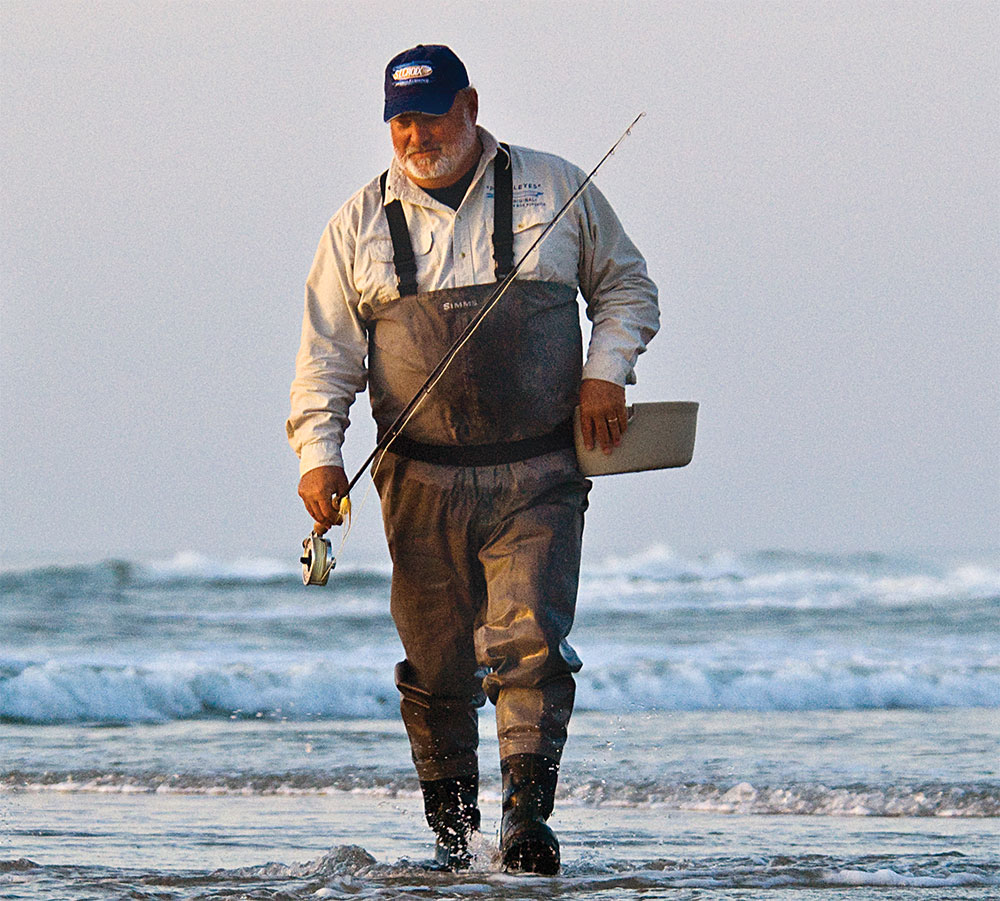
Bob Popovics’ Surf Candy
One of the most iconic flies in the history of saltwater fly-fishing came about because of bluefish. Or, more accurately, because of what happens to a fly when a bluefish eviscerates one with its teeth. On the sandy beaches of New Jersey, Bob Popovics would patiently wait for the blues to push close enough to cast to, only to hook one and be left with the gnarled remains of bucktail left after the fight. He brought this frustration home with him and applied it to his vise, eventually leading to the groundbreaking epoxy pattern known as the Surf Candy.
“It was all for durability,” Popovics said. “I just wanted something that would last on the beach.”
Popovics got into fly-fishing in 1969, fresh from a stint in the Marine Corps in Vietnam. His friend Butch Colvin Butch’s father, Cap, owned a tackle shop, taught him how to cast, and eventually, Popovics became equally interested in fly tying.
“Back then you had blondes, tarpon flies, a streamer or two and poppers — that’s it,” he said.
Young tiers, including Popovics, started experimenting. A few tiers, such as Mark Sosin, were using epoxy to protect the thread wraps on their patterns.
A Step Further
“I’d been putting epoxy on the head of my blondes where the thread was and I thought, ‘Let’s just carry that epoxy all the way down the shank and see what I get,'” Popovics said.
The first iterations of the Surf Candy were crude and were made with bucktail and didn’t have eyes or gill markings. They were just something to break out when the bluefish came around. Popovics focused his tying energies elsewhere, into groundbreaking designs that imitated large menhaden — the preferred food of large striped bass.
When the striped bass population underwent a staggering decline in the late 1970s and early 1980s, participation in saltwater fly-fishing declined in the Northeast along with it. But Popovics kept persevering, logging long hours at the beach and at the vise. He’d invite other anglers like Andy Renzetti and Ed Jaworowski to his house to collaborate. During this ebb, he revisited his original epoxy fly to see if he could improve it. His goal was to more accurately represent more streamline-shaped baits like the anchovy, sand eel or silverside.
Key Ingredients
“My mind was working a mile a minute with all kinds of ideas,” he recalled. “I used to lay my flies on the floor and look at them like they were lined-up toy soldiers. This one doesn’t look as good as that one. Why?”
Popovics learned to use his bodkin to carefully sculpt and cure the epoxy around the bucktail to create a lifelike baitfish body shape. He also started painting on eyes and gills. But using two new materials changed the Surf Candy as people know it today.
The first was prism eyes. Fred Schrier, a founder of the original Saltwater Fly Rodders of America and an early influence on Popovics, had started a tackle company. He put prism eyes on traditional lead bucktail jigs, and Popovics asked him for the smallest ones he could find. From this point on, Popovics’ Surf Candies had realistic, reflective eyes.
The second came around 1983, when Ed Jaworowski showed up at a tying session at Popovics’ house with a bag full of ultra hair. In addition to being more durable than bucktail, the synthetic material was translucent and moved in a lifelike manner underwater. It worked. In their seminal fly-tying book Pop Fleyes, Popovics and Jaworowski recall the anecdote of their friend Lance Erwin bursting into the house after catching 25 bluefish with a single fly. And the fly remained intact.
The Surf Candy started making waves among local anglers and some of Popovics’ close friends in the fly-fishing community. In 1990, the American Angler & Fly Tyer published an article on Popovics’ work, introducing his Surf Candy to a national audience. Perfect timing.
The striped bass moratorium had just ended and anglers along the Atlantic coast were experiencing the rebound that launched a decade of ridiculous fishing. Also, the movie A River Runs Through It came out in 1992, drawing thousands to the sport. The Surf Candy, along with other patterns such as the Clouser minnow and Lefty’s Deceiver, became one of the iconic flies of the coastal fly-fishing revolution.
Tweaking a Classic
Jonny King, today a prominent fly tier in his own right, recalls discovering the Surf Candy in an Orvis shop in Boston. He cast one into a froth of silversides pinned against the rocks by stripers. “I remember I kept getting hammered and thinking, ‘This is the coolest fly I’ve ever seen.'”
Popovics’ designs and tying style had a huge influence on King and others, such as Dave Skok. An explosion of patterns incorporating epoxy and synthetic hair burst on the scene, many with roots tracing to the Surf Candy.
Popovics himself has continued to evolve the pattern, including replacing epoxy with fast-curing acrylics such as Tuffleye, which was introduced to Popovics in 2002 by a dentist from Texas named Ned Lunt.
Now, Popovics has evolved the Surf Candy a step further, creating Fleye Foils — reflective cutouts with eyes and gill markings and belly sacks cut to accurately represent a baitfish profile. The foils come in different shapes to mimic sand eels, bay anchovies or silversides. They are pressed over the craft fur on either side of the shank and are encased in acrylic in typical Surf Candy style.
They still work around the country and particularly on the bluefish running the beaches of New Jersey, where Popovics still fishes every chance he gets.









